Best Containers for Breeding Minnows

When it comes to creating a thriving freshwater ecosystem, choosing the right habitat is crucial. A carefully selected environment can mean the difference between a successful breeding experience and a disappointing outcome.
This is particularly true when breeding minnows, as these small fish are sensitive to their surroundings and require precise conditions to thrive.
Why the Right Container Matters
Breeding minnows requires a clever choice of aquarium containers that provide the perfect setting for these small fish to flourish.
The right container is essential for maintaining water quality, promoting healthy growth, and ensuring a successful breeding experience.
Key Considerations for Choosing the Best Container
When selecting a container for breeding minnows in a freshwater ecosystem, it is crucial to consider factors such as the size and shape of the container, the type of aquarium gravel or pebbles used for the habitat, and the overall environment that will be created for the fish and other aquatic life.
What Is Breeding Habitat Environment Like
When it comes to aquatic animals, the environment in which they breed can make all the difference between success and failure. The time and effort invested in creating the perfect breeding habitat can pay off with a thriving brood.
The breeding habitat environment for aquatic animals plays a crucial role in ensuring the success of their reproduction, and it’s essential to create an environment that simulates their natural habitat as closely as possible.
This can be achieved by providing a suitable foundation, like gravel, that allows for easy digging and hiding.
Consistent water quality is vital for breeding, and this can be maintained by using a high-quality filter that produces both oxygen-rich and aerated water. The ideal water temperature for breeding varies depending on the species, but a general temperature range of 72 to 82°F is suitable for most aquarium fish. Aquatic plants are also an important aspect of maintaining a healthy and thriving aquarium, requiring a proper gravel substrate, filtered and aerated water, adequate oxygen quality, and regular maintenance and care.
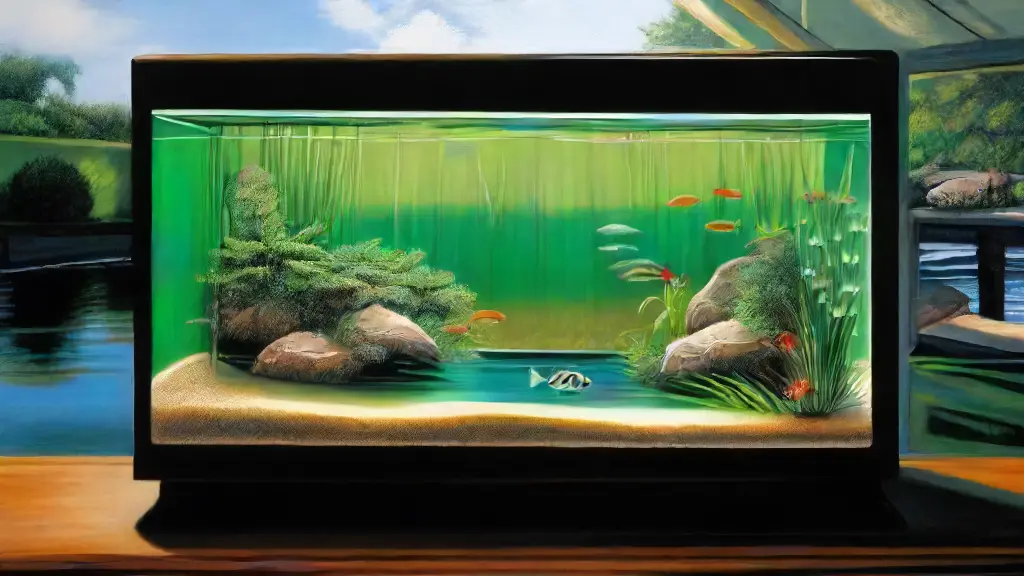
What Do Minnows Need In Container Setup
Minnows are a delight to observe, with their vibrant colors and intricate behaviors. To create a thriving environment for these fascinating creatures, it’s essential to understand their specific needs.
Habitat Construction
——————-
Provide a suitable substrate, such as sand or gravel, to mimic their natural environment.
Adding plants can also enhance shelter and visual interest for your minnows.
Ensure proper filtration and circulation to maintain clean and oxygen-rich water.
Minnows are sensitive to water conditions and require a specific range of parameters to thrive.
Water Conditions
—————-
Set water temperature between 65-78°F (18-26°C) to ensure optimal growth. Maintain a pH level between 5-5, as minnows are sensitive to extreme acidity or alkalinity.
Minnow Care Facts
- Minnows require a specific range of water parameters to thrive.
- Proper filtration and circulation are essential to maintain clean and oxygen-rich water.
- Minnows are sensitive to extreme acidity or alkalinity, with a recommended pH level of 5-
- Minnows require a water temperature between 65-78°F (18-26°C) for optimal growth.
Can Breeding Containers Be Filtered
Aquaculture breeders have long emphasized the importance of a secure foundation for their fish, where every variable is carefully controlled to promote optimal health. Proper water parameters being a crucial component of this process.
The purpose of breeding containers in aquaculture is to provide a controlled environment for fish to thrive, and reduce stress and mortality rates.
Effective regulation of conditions is essential to maintain optimal parameters, as it helps to govern water pH, hardness, and alkalinity.
Water changes, circulation, and aeration also play a vital role in maintaining quality, which is critical for fish health and breeding success.
Careful consideration is given to hiding suitable hiding places and ensuring sufficient shelter for fish to feel secure in their environment.
By striking the perfect balance between these factors, breeders can minimize stress and maximize the chances of successful breeding.
Why Is Pebbles Gravel Substrate Important
Aquarium enthusiasts know that creating a thriving ecosystem requires a delicate balance between water quality and habitat stability. The right substrate is essential to achieving this harmony, and pebbles gravel substrates are a crucial component.
The pebbles gravel substrate, in particular, is a cornerstone of a healthy aquatic environment, providing a durable foundation for plants and animals alike.
Physical and Chemical Properties:
Pebbles gravel substrate boasts excellent water circulation, allowing for efficient exchange of gases and removal of waste products, making it a safe haven for aquatic life.
The rocks beneath the surface also provide a secure footing for plants to anchor themselves.
Its chemical properties also play a vital role in maintaining a stable pH and temperature, creating a sheltered environment for fish and other aquatic organisms to thrive. In addition, the aquarium provides a secure and escapeproof shelter with durable acrylic walls, easy cleaning, and safe access to rocks and caves, making it a safe haven for aquatic animals amidst the plastic and glass debris often found in the ocean.
Facts About Pebbles Gravel Substrate
- Pebbles gravel substrate provides excellent water circulation for efficient exchange of gases and removal of waste products.
- The rocks beneath the surface of the pebbles gravel substrate provide a secure footing for plants to anchor themselves.
- Pebbles gravel substrate helps maintain a stable pH and temperature, creating a sheltered environment for fish and other aquatic organisms.
- The durable acrylic walls of the aquarium provide a secure and escapeproof shelter for aquatic animals.
How Can Aquarium Supplies Enhance Environment
Creating a thriving aquarium ecosystem requires a delicate balance of factors, with the right supplies playing a crucial role in maintaining optimal conditions. Adjustable water parameters, such as pH levels, play a vital part in sustaining fish health, and a well-chosen range of aquarium equipment can significantly impact these conditions.
Aquarium conditions, including pH levels, water temperature, and water hardness, can have a profound effect on aquatic life.
A slight deviation in these parameters can lead to stress, disease, and even mortality in fish.
Detachable filtration systems, compact heating and cooling units, and modular aeration and oxygenation systems are just a few examples of the equipment available to aquarists. These supplies not only enhance the environment but also simplify maintenance and management tasks, making it easier to provide a stable and buoyant habitat for aquatic creatures. Regular water changes, monitoring and adjustments enabled by the adjustable, detachable, removable, modular, scalable, compact, portable, transportable, easy transport, and easy relocation features, providing stability and buoyancy to the system.
What Is Best Container Water Volume Size
Aquatic enthusiasts often underestimate the significance of water volume in their aquariums, neglecting the delicate balance that it maintains. As a result, many aquariums fall short of providing a healthy and thriving environment for their inhabitants.
Defining Water Volume Requirements for Aquatic Life
For instance, breeding fish require a certain level of water volume to accommodate their growth and movement, with visibility into the water height being a crucial factor.
Fish that are unable to fully submerge themselves may exhibit abnormal behavior, such as frequent floating or sinking.
Calculating Water Volume Needs for Optimal Fish Health
The level of water depth can affect the overall water quality, as it determines the volume of water parameter fluctuations. Monitoring water levels and adjusting the water depth can be crucial to ensure clear visibility and prevent submergence or sinking of objects.
Aquarium Water Volume
- Water volume affects the ability of fish to fully submerge themselves, with inadequate volume leading to abnormal behavior.
- A minimum water volume of 1 gallon per inch of fish is recommended for optimal fish health and movement.
- Water depth can affect water quality, with changes in depth causing fluctuations in water parameters.
- Regular monitoring and adjustment of water levels and depth is crucial to maintain a healthy and thriving aquatic environment.
Can Breeding Containers Be Portable Durable
Aquarium enthusiasts have long grappled with the challenge of creating a harmonious environment that fosters the growth and reproduction of aquatic life. As scientists unravel the intricacies of fish biology, breeders are now poised to harness cutting-edge technology and innovative design principles to revolutionize the way they care for their finned friends.
Defining the Problem: Inadequate Solutions in Fish Breeding
Traditional aquariums often struggle to provide the ideal environment for fish breeding, with inadequate space, poor air circulation, and limited control over water temperature and chemistry. The aquarium may be able to replicate a natural day-night cycle by incorporating UV and infrared lights, along with heat and cold sources, and monitoring the climate with a thermometer and hydrometer to ensure the optimal photoperiod.
Is Artificial Lighting Important For Breeding
As aquarium owners, we often focus on the right water chemistry and healthy aquatic plants, but a crucial aspect of breeding success is often overlooked – artificial lighting. In many respects, it’s the unsung hero of aquarium maintenance, playing a vital role in the delicate balance of our underwater worlds.
For enthusiasts, artificial lighting is a vital component of maintaining optimal water chemistry and promoting healthy aquatic plants.
But did you know that the right lighting can also significantly impact the breeding process?
When it comes to breeding, pH meters and water test kits are essential tools for ensuring the perfect balance of water parameters.
But what about lighting? The wrong spectrum or intensity can hinder breeding success, while the right lighting can boost growth rates and enhance coloration. As those who’ve spent countless hours perfecting their aquarium supplies and equipment, I’ve seen firsthand the benefits of artificial plants growing in water with stable pH levels, as monitored by my trusty pH meter and tested regularly with my reliable test kit.
Artificial Lighting for Aquarium Breeding
- Artificial lighting can significantly impact the breeding process, with the wrong spectrum or intensity hindering breeding success and the right lighting boosting growth rates and enhancing coloration.
- Proper lighting can help maintain optimal water chemistry, which is essential for promoting healthy aquatic plants and breeding success.
- A stable pH level, monitored by a pH meter and tested regularly with a reliable test kit, is crucial for breeding success and can be achieved with the right artificial lighting.
- Artificial lighting can also enhance the coloration of aquatic plants, making them more vibrant and healthy-looking.
How to Maintain a Worm Farm for Fishing Bait
How to Raise Insects for Fishing Bait
How to Raise Insects for Fishing Bait

The art of reeling in the big ones has long been a cherished pastime for many anglers, and one of the most effective ways to do so is by harnessing the power of insects as live bait. By cultivating grasshoppers and crickets in their natural habitats, both terrestrially and aquatically, we can unlock a secret that has been hidden away in the realm of entomology.
Grasshoppers, in particular, are an excellent choice for angling.
They are abundant, nutritious, and have a unique movement pattern that attracts a wide range of species, including bass, trout, and panfish.
The success of grasshopper farming is heavily dependent on the aquatic ecosystems in which they are raised. By mimicking the unique characteristics of aquatic ecosystems, terrestrial habitats, and insect husbandry, entomology has evolved to encompass insect breeding, cricket ranching, and grasshopper farming with expertise.
How to Raise Insects for Fishing Bait
As an angler, I’ve discovered that the key to a successful catch often lies in the presentation and authenticity of the bait. By cultivating your own insects, you can create a tailored approach that exceeds store-bought alternatives in terms of effectiveness and cost-effectiveness.
Live bait is essential for many types of fishing, including recreational fishing, as it provides a natural and appealing target for fish to feed on, requiring careful insectary management to optimize growth stages.
For starters, live bait is more likely to attract fish than artificial lures, as it provides a real food source that fish can recognize and feed on, with insect feeding habits playing a crucial role in attracting species. in order to provide them with high-quality and nutritionally suitable food options.

What Insects Make Good Live Bait
The art of fishing has always been deeply rooted in the use of live bait, and for good reason. Insects have been a staple in many fishing cultures for centuries, with their unique characteristics and behaviors making them highly effective at attracting fish.
I.
Introduction to Insects as Live Bait
Insects offer an intriguing combination of appealing senses, such as sight, sound, and smell, which can trigger a fish’s instinct to strike during their insect metamorphosis.
In addition, their natural insect development makes them a perfect match for fishing techniques like bottom fishing or suspend fishing.
Insects are an abundant and renewable resource, making them an eco-friendly and cost-effective option for fishermen as they undergo insect molting. By understanding the different types of insects that can be used as bait in insect-based fishing.
| Types of Insects | Effective Fishing Techniques | Abundance | Eco-Friendliness |
|---|---|---|---|
| Insect Metamorphosis | Bottom Fishing, Suspend Fishing | Abundant and Renewable | Eco-Friendly and Cost-Effective |
Are Grasshoppers the Best Live Bait
Fishing for success requires more than just a good fishing spot or a sturdy rod. It’s often the subtle nuances, such as the choice of live bait, that can make all the difference between reeling in a prized catch and returning home empty-handed.
Grasshoppers have become a sought-after option for anglers seeking to land a trophy fish, thanks to their remarkable adaptability.
Capable of thriving in a wide range of terrestrial environments, from lush meadows to parched deserts, these insects have evolved to survive and thrive in diverse ecological niches.
Grasshoppers are an adaptive species, capable of thriving in a wide range of aquatic environments, from slow-moving streams to fast-paced rivers. This adaptability makes them an attractive option for anglers targeting a variety of terrestrial species. To successfully identify and conserve grasshopper populations, understanding their life cycles and habitat requirements is essential, as it allows for targeted monitoring and management of both aquatic and terrestrial species, as well as informing insect classification, taxonomy, identification, detection, recognition, and monitoring.
Crickets for Bait: Choosing the Right Species
In the world of outdoor enthusiasts, understanding the intricate details of insect life stages and survival rates is crucial for success. When it comes to angling and hunting, few species have gained popularity as live baits as crickets, and for good reason.
.
You may wonder what makes these insects so appealing to anglers and hunters.
The answer lies in the unique characteristics and characteristics of different cricket species suitable for bait.
- Types of crickets for bait include the popular grasshopper, camel cricket, and house cricket, each with its own set of sizes, colors, and life cycles.
.
When choosing a species, it’s essential to consider the nutritional value and palatability of your cricket bait. This is key to understanding how insects adapt to and thrive in their aquatic and terrestrial habitats.
Key Facts About Cricket Baits
- Grasshoppers, camel crickets, and house crickets are popular species used as live baits.
- Different cricket species have varying sizes, colors, and life cycles, making each suitable for specific angling and hunting purposes.
- When choosing a cricket species for bait, nutritional value and palatability are crucial factors to consider.
- Understanding the life stages and survival rates of insects is essential for success in outdoor activities like angling and hunting.
Insect Housing: Designing an Effective Enclosure
Wildlife conservation efforts have a long history of emphasizing the importance of habitats for species survival, but fewer people realize that effective enclosures are just as vital for certain insect populations. In fact, strategically designed insect houses can revolutionize our approach to sustainable fishing and terrestrial ecosystems management.
In the world of fishing, insects play a vital role as bait, and the importance of proper breeding cannot be overstated.
For instance, did you know that crickets, mealworms, and waxworms are some of the most commonly used insects for fishing bait? To ensure a successful breeding process, it is essential to provide the right environment for the insects.
When designing an enclosure, the size and material used are crucial factors to consider. A well-ventilated area with precise temperature control is also vital to maintain, ultimately contributing to optimal conditions for sustainable fishing practices and the conservation of insect diversity.
Providing the Right Food for Your Insect Bait
As we navigate the complexities of maintaining a healthy environment and controlling insect populations, it’s essential to recognize the critical role that food plays in the lives of these tiny creatures. In today’s world, where every little detail counts, understanding the importance of providing the right food for your insect bait has become increasingly relevant.
I.
Importance of Nutritious Food for Insect Development
Nutrition plays a vital role in shaping the growth and vitality of insects.
Malnutrition can have severe consequences on insect health, leading to reduced reproduction rates, lower survival rates, and increased susceptibility to disease.
II.
Nutrient-Rich Insect Diets for Breeding Live Bait
Several insect species are commonly used as fishing bait, including crickets, mealworms, and waxworms. Insect management requires crucial nutrients such as protein, fat, and carbohydrates.
How to Handle Insects for Live Bait
Freshwater anglers and enthusiasts often rely on live bait to increase their chances of reeling in a big catch, but few people realize the complex process involved in obtaining this delicate cargo. Insect farming, or breeding farms, have become a popular method for providing anglers with a steady supply of fresh, nutritious bait.
One of the keys to success in insect breeding farms is choosing the right habitat for your insect colony.
Selecting the proper insect distribution materials, such as tubes or containers, is crucial for housing your insects and providing them with the necessary food and water.
Optimal breeding conditions are crucial for ensuring a healthy and thriving colony.
Maintaining the right temperature, humidity, and lighting levels, as well as providing adequate insect sales supplies, is vital for insect survival and growth. Colony maintenance and research.
Ensuring Insect Health and Survival for Fishing
The secret to a fruitful fishing experience lies in the intricate web of relationships between aquatic ecosystems, fish populations, and the tiny, yet mighty, insects that inhabit them.
As any seasoned angler knows, a successful fishing trip relies heavily on the quality and health of the bait used.
Many anglers overlook the importance of insect health and survival, failing to understand the critical role they play in ensuring a sustainable fishing experience.
Without a doubt, healthy insects are crucial for sustainable fishing practices.
Neglecting their health can lead to a decline in fish populations, reduced fishing yields, and ultimately, the demise of entire ecosystems. So, what can be done to ensure the health and survival of these tiny, but mighty, creatures? For starters, it’s essential to adopt proper insect husbandry practices, providing them with a suitable environment that meets their dietary needs through a balanced insect nutrition plan, ensures their overall health through preventative care and early detection of diseases, and prioritizes their wellbeing through humane insect handling techniques and a stress-free insect welfare environment.
| Insect Health Indicators | Impact on Fishing Experience |
|---|---|
| Proper Insect Nutrition Plan | Ensures Healthy Insects for Sustainable Fishing |
| Early Detection of Diseases | Prevents Decline in Fish Populations and Ecosystems |
| Stress-Free Insect Welfare Environment | Promotes Insect Survival and Wellbeing |
Best Containers for Breeding Minnows
Best Techniques for Raising Live Shrimp
Best Techniques for Raising Live Shrimp

In the world of aquatic life, proper management is crucial for the growth and health of crustaceans. Brine shrimp, a popular bait option, demands attention to detail in terms of water quality, temperature, and pH levels.
Water Quality
Proper water quality is crucial for shrimp cultivation.
Decapod crustaceans thrive in marine environments, and a combination of good water circulation, aeration, and regular water testing can help maintain a healthy environment for these sensitive creatures.
Marine aquarium enthusiasts can attest to the importance of regular water changes and monitoring to ensure optimal conditions for shrimp growth. Feeding Techniques.
How to Optimize Water Conditions
The delicate balance of water conditions plays a significant role in determining the overall health and longevity of aquatic life, often taking a backseat to the visual appeal of the aquarium’s inhabitants.
Water Conditions: The Silent Killer of Aquatic Life
PH levels are crucial for aquatic life, as it directly affects the ability of fish to absorb essential nutrients.
A pH level that is too high or too low can lead to a range of health issues, including respiratory problems and digestive disorders.
Avoidance of sudden pH changes is vital, and it’s recommended to test water pH regularly.
This can be done using a reliable pH test kit, and adjustments can be made accordingly. For most aquariums, maintaining a stable pH level is crucial for the health and well-being of the ornamental fish.

What is the Ideal pH
Understanding the delicate balance of aquatic ecosystems starts with recognizing the critical role water pH levels play in determining the well-being of its inhabitants, including the prized seafood, shrimp. Shrimp are an integral part of the aquatic ecosystem, and their health is heavily influenced by the water’s composition.
Water pH, abbreviated as pH, measures the acidity or basicity of a solution.
In an aquatic environment, pH plays a crucial role in determining the availability of essential nutrients, thus affecting the overall health and growth of shrimp.
Strong water circulation systems, which are designed to maintain optimal water quality, often overlook the importance of pH in shrimp ecosystems, where shrimp rely on aeration to extract oxygen from the water.
Most people are unaware that the impact of pH on shrimp behavior, health, and growth is significant. For instance, elevated pH levels can lead to reduced palatability of food, while ensuring optimal nutrition and circulation within the aquatic environment.
Aquatic Ecosystems
- Water pH levels can affect the availability of essential nutrients for shrimp, impacting their overall health and growth.
- Optimal water circulation systems are crucial for maintaining a healthy aquatic environment, but often overlook the importance of pH levels.
- Elevated pH levels can lead to reduced palatability of food for shrimp, affecting their nutrition and growth.
- Shrimp rely on aeration to extract oxygen from the water, making water pH levels a critical factor in their well-being.
Is Brine Shrimp Suitable
Sustainable protein production is a pressing concern in modern aquaculture, driving the demand for innovative and environmentally friendly solutions. As an emerging aquaculture industry, brine shrimp cultivation has garnered significant attention for its potential to provide a sustainable source of protein for both human consumption and animal feed.
Understanding the life cycle of brine shrimp is crucial to determine their suitability for various applications.
Brine shrimp, also known as Artemia salina, undergo a unique life cycle that consists of three main stages: nauplii, copepodid, and adult.
Key factors to consider when raising brine shrimp include maintaining optimal water parameters, such as chlorine removal, to promote healthy fatty acid production. The water should be slightly alkaline, with a pH range of 5-5, allowing for optimal protein content. The facility was designed to meet all the environmental requirements, including growth rates, fatty acid, protein content, feeding frequency, water conditioning, chlorine removal, and bacteria.
How to Maintain Circulation
Healthy bodies rely on a intricate dance of biological processes to function seamlessly, and nowhere is this more apparent than in our circulatory system. As oxygenated blood flows through our veins, it delivers vital nutrients and removes waste products, a delicate balance that’s essential for maintaining overall well-being.
The importance of maintaining optimal circulation extends beyond physical health, as it also has a significant impact on mental well-being.
When circulation is compromised, it can lead to feelings of fatigue, anxiety, and depression, further emphasizing the need for a proactive approach to maintaining healthy blood flow. Ultimately, the circulation of nutrients in a stream is highly dependent on the presence of biofilm, nitrifying bacteria, and the nitrogen cycle, which is influenced by factors such as bicarbonate, carbon dioxide, phosphorus, and ammonia.
| Biological Process | Importance | Impact on Health |
|---|---|---|
| Oxygenation of Blood | Delivers vital nutrients and removes waste products | Essential for maintaining overall well-being |
| Biofilm and Nitrifying Bacteria | Dependent on factors such as bicarbonate, carbon dioxide, phosphorus, and ammonia | Influences circulation of nutrients |
| Circulation of Nutrients | Delicate balance between delivery and removal of waste products | Compromised circulation can lead to feelings of fatigue, anxiety, and depression |
What is the Importance of Feeding
The delicate balance of aquatic ecosystems is underpinned by the tiny threads of nutrition, which weave life together in intricate harmony.
Aquatic ecosystems are intricate networks, where even the tiniest components play crucial roles.
One such crucial aspect is nutrition, which influences the overall health, well-being, and growth of aquatic life.
Role of Nutrition in Aquatic Life
• Nutritional deficiencies can have far-reaching consequences, impacting not only overall health but also reproductive cycles.
Inadequate diet can lead to reduced fertility, affecting the very survival of aquatic species.
• A improper nutrition can also affect physical development, leading to stunted growth, reduced strength, and compromised immune systems. Impact of Feeding Habits on Growth and Development
Optimal nutrition is essential for proper growth and development, as bioavailable nutrients enable aquatic organisms to thrive in their environment, and a balanced diet rich in nitrite, nitrogen oxide, oxygen, and carbonaceous digestion, while utilizing denitrification processes, is crucial for their overall health, as evident in the use of dietary supplements that enhance bioavailability.
How to Monitor Growth Rates
In the world of aquaculture, tracking the progress of fish growth is a crucial aspect of ensuring a thriving and sustainable farming operation. Fish growth rates are a vital indicator of aquaculture success, as they reflect the effectiveness of hatchery practices, feed formulation, and overall farm management.
Understanding the importance of tracking progress in this regard is vital, as it enables farmers to make informed decisions about breeding and feeding programs, ultimately resulting in cost savings and increased profitability.
Measuring Growth Rates
Defining parameters for assessment is the first step in monitoring growth rates.
This typically involves measuring size and weight of fish at regular intervals, using techniques such as weighing and measuring using calipers.
Regular monitoring is essential to detect any potential issues early on, such as disease outbreaks or nutrient deficiencies, which can impact growth rates. The growth of aquatic plants in an aquarium is influenced by multiple factors, including Live food, Aquatic plants, Seaweed, Fertilizers, Nutrients, Trace elements, Micronutrients.
Key Points About Aquaculture Growth Tracking
- Fish growth rates are a vital indicator of aquaculture success, reflecting effectiveness of hatchery practices, feed formulation, and overall farm management.
- Regular monitoring of fish growth is essential to detect potential issues early on, such as disease outbreaks or nutrient deficiencies, which can impact growth rates.
- Measuring size and weight of fish at regular intervals, using techniques such as weighing and measuring using calipers, is a crucial step in monitoring growth rates.
- Understanding the importance of tracking progress in aquaculture enables farmers to make informed decisions about breeding and feeding programs, resulting in cost savings and increased profitability.
Can I Use Live Food
The health of aquatic life relies heavily on a balanced and nutrient-rich diet, with the right mix of essential elements and supplements playing a crucial role in maintaining optimal well-being. A harmonious blend of vitamins and minerals is vital for achieving this delicate balance, where crucial components like calcium, iron, and magnesium work together to support strong bones and shells.
Aquatic nutrition is a complex process that involves not only the quality of food but also the water quality in which the aquatic life flourishes.
Vitamin supplements, like calcium, help regulate metabolism and growth, while magnesium supplements facilitate energy production.
Iodine, a vital mineral supplement, plays a critical role in thyroid function, and copper supplements support immune function.
In this context, live food becomes a vital component of aquatic nutrition, providing essential nutrients and vitamins that may be lacking in artificial diets. Incorporating a well-balanced diet rich in Mineral supplements, Vitamin supplements, Iodine, Calcium, Magnesium, and Iron, and also Copper.
What are the Best Water Quality
Water is a vital component of life, and its quality plays a crucial role in sustaining ecosystems and human health. From the purest mountain springs to the saltiest ocean depths, water’s unique characteristics define its purpose and function.
| Natural vs.
Processed Water |
Aquatic ecosystems are characterized by varying water compositions, from Zinc-rich freshwater sources to Turbidity-stricken brackish water.
While natural water sources, like Ocean water, undergo Transparency transformations, processed water undergoes alterations to achieve desired quality.
Natural sources, like Freshwater, tend to have a lower Turbidity level compared to Brackish water, which has higher levels of Salt and Mineral concentrations. Processing water can alter its chemistry, especially when it contains high levels of zinc from brackish or saline sources and has low transparency due to turbidity from freshwater or ocean water.
Water Quality Facts
- Natural water sources like ocean water undergo transparency transformations, while processed water undergoes alterations to achieve desired quality.
- Natural freshwater sources tend to have a lower turbidity level compared to brackish water, which has higher levels of salt and mineral concentrations.
- Processing water can alter its chemistry, especially when it contains high levels of zinc from brackish or saline sources and has low transparency due to turbidity from freshwater or ocean water.
- Aquatic ecosystems are characterized by varying water compositions, from Zinc-rich freshwater sources to Turbidity-stricken brackish water.
How to Raise Insects for Fishing Bait
How to Breed Frogs for Live Bait
How to Breed Frogs for Live Bait

The fascination with fishing often leads many to seek out the right bait to reel in a successful catch. To achieve this, having a reliable source of live bait is crucial, and one such option is breeding frogs.
What to Expect
When it comes to bringing frogs into your home, it’s essential to understand the intricate details of their biology and needs. Frog guardianship requires a deep understanding of the intricacies of frog biology, and the initial setup and preparation is a crucial step in ensuring a healthy environment.
Creating a suitable environment involves controlling temperature, humidity, and lighting to mimic the natural habitats of the frogs.
This means maintaining a consistent temperature range, providing adequate ventilation, and creating a humid microclimate.
Proper diet is also essential, and this involves providing a stable supply of nutritious food for the frogs, supporting optimal development from frog species selection to larvae development. Different species have specific dietary requirements, and understanding these needs is vital for ensuring the health and well-being of the frogs. When selecting the right frogs for breeding, it’s essential to choose healthy, fertile individuals, which requires knowledge of frog biology, frog care, frog species selection, habitat creation, humidity control, and larvae development and life stages.

Frog Care Essentials
As enthusiasm for amphibians grows, many are seeking a reliable and profitable way to obtain a consistent supply of high-quality bait, leading to a surge in frog breeding ventures. Understanding the basics of amphibian biology is crucial for success, and this article aims to provide a comprehensive guide to frog care essentials.
I.
Introduction to Frog Breeding
Before diving into the world of frog breeding, it’s essential to understand the different species suitable for breeding, each with its unique characteristics and breeding requirements.
This includes species like the African dwarf frog, American bullfrog, and European common frog.
Correct equipment and supplies are also vital for a successful breeding operation, including a suitable terrarium setup, temperature regulation, and pH level control, as well as a reliable feeding system and maintenance routine.
Let me know if you.
Frog Breeding Essentials
- Frog breeding requires a suitable terrarium setup, including a secure and escape-proof enclosure with adequate ventilation and humidity control.
- African dwarf frogs, American bullfrogs, and European common frogs are popular species for breeding due to their relatively easy care and high demand in the pet trade.
- Temperature regulation is crucial for frog breeding, with most species requiring a temperature range of 65-85°F (18-29°C) during the day and a slight drop in temperature at night.
- A reliable feeding system is essential for maintaining the health and well-being of breeding frogs, including a varied diet of live and frozen/freeze-dried foods.
Controlled Environment Setup
As you embark on the journey of frog breeding, you’ll soon realize that the right environment is everything. The delicate balance of environmental factors can make all the difference between success and failure.
In fact, the optimal water chemistry is where many breeders start, as it’s a vital component in the well-being and health of the aquatic life. Let me know if you’d like me to proceed with the next section!.
Eggs and Larvae Development
The mesmerizing world of amphibians holds many secrets, and one of the most intriguing aspects is the intricate dance of development that unfolds within the eggs and larvae of these fascinating creatures.
Frog eggs, also known as spawn, typically thrive in water environments, encompassed by a jelly-like substance that surrounds a mass of yolk sacs, providing sustenance for the developing tadpoles.
As tadpoles emerge, they undergo a series of developmental milestones, transitioning from aquatic to terrestrial habitats.
Understanding the optimal incubation conditions for eggs and the most effective methods for monitoring and maintaining water quality is crucial for successful larval development.
Proper feeding and nutrition are also vital for tadpole growth and metamorphosis, with aquatic plants providing a crucial food source during their aquatic life cycle.
Amphibians
- Frog eggs typically thrive in water environments, surrounded by a jelly-like substance that provides sustenance for developing tadpoles.
- Tadpoles undergo a series of developmental milestones, transitioning from aquatic to terrestrial habitats, and require optimal incubation conditions and water quality for successful larval development.
- Aquatic plants provide a crucial food source for tadpoles during their aquatic life cycle, and proper feeding and nutrition are vital for tadpole growth and metamorphosis.
- The developmental process of amphibians is a complex and intricate dance, with multiple factors influencing the success of larval development, including optimal incubation conditions, water quality, and nutrition.
Habitat Design Considerations
When designing environments for amphibians, it’s essential to consider the intricate relationships between their native habitats and the delicate balance of aquatic life. In designing a suitable habitat for amphibians, it’s essential to prioritize the delicate balance of their ecosystem, ensuring optimal conditions for growth, development, and health.
The first level of consideration is creating a suitable environment, which begins with understanding water quality and undergoing an aquatic ecosystem assessment.
Water temperature and pH play a crucial role in amphibian development, and aquatic ecosystem management requires maintaining an optimal range.
For example, tadpoles are sensitive to temperature fluctuations, and extreme pH levels can impact growth and development, affecting the aquatic food source. Proper aquatic ecosystem function is vital for aquatic health monitoring and maintenance. Ensuring proper ventilation and humidity control are vital in maintaining a healthy aquatic habitat design and optimizing the balance of aquatic ecosystem function.
Water Quality Control Measures
As the delicate balance of aquatic habitats is disrupted by human activities, ensuring the quality of water is crucial for the survival and flourishing of a wide range of aquatic life stages, providing essential aquatic services to our planet.
Water quality control measures aim to maintain optimal conditions for aquatic life stages to develop and flourish. Regular water tests are essential to monitor pH, temperature, and dissolved oxygen levels, which can significantly impact aquatic life.
For instance, pH levels that are too high or too low can affect frog health, while temperature fluctuations can cause stress among aquatic organisms.
Acid-base management is critical to maintaining optimal pH levels, which can be achieved through the use of acid-base neutralising agents or by manipulating the water flow within aquatic habitats. a variety of aquatic species.
Water Quality Control
- Water quality control measures can significantly impact the survival and flourishing of aquatic life stages.
- Pollution can alter pH levels, temperature, and dissolved oxygen levels, affecting aquatic life.
- Regular water tests are essential to monitor pH, temperature, and dissolved oxygen levels in aquatic habitats.
- Acid-base management is critical to maintaining optimal pH levels in aquatic habitats, which can be achieved through the use of acid-base neutralising agents or by manipulating the water flow.
Live Bait Production Methods
Introducing a thriving ecosystem, where the sounds of chirping frogs and gentle water ripples harmonize with the thrill of catching the catch of the day. Live bait production methods, a coveted art among amphibian enthusiasts and anglers, rely heavily on the intricacies of frog breeding.
Briefly, frog breeding has a rich history that dates back thousands of years, with ancient cultures recognizing the importance of these tiny creatures for both food and medicine.
Today, breeding frogs is a popular hobby and profession, with many enthusiasts and professionals seeking to produce high-quality live bait for fishing and other purposes.
In order to set up a successful frog breeding operation, it’s essential to choose the right enclosure, providing adequate lighting and temperature control, as well as a proper housing and feeding system. This may involve selecting a suitable substrate, such as sphagnum moss or reptile bark, and ensuring the highest quality control throughout all services.
Sustaining a Healthy Ecosystem
New technologies are revolutionizing the way we approach the quest for sustainable living, as we grapple with the pressing issue of environmental degradation.
Biodiversity plays a vital role in maintaining healthy ecosystems, with a diverse range of species, habitats, and ecosystems working together in harmony to support life on Earth.
Human activities such as deforestation, pollution, and climate change are having a devastating impact on our planet’s biodiversity, threatening the very fabric of our ecosystem.
To mitigate this issue, it’s crucial to adopt eco-friendly practices that prioritize water care, reducing our environmental footprint and promoting sustainable living.
From sustainable agriculture to responsible resource management, every small step counts in our quest to sustain a healthy ecosystem, ensuring water quality management and reducing the risk of water pollution. leads to better water quality, tank maintenance, and ultimately, sustainability.
Best Techniques for Raising Live Shrimp
Best Ways to Harvest Worms for Fishing
Best Ways to Harvest Worms for Fishing
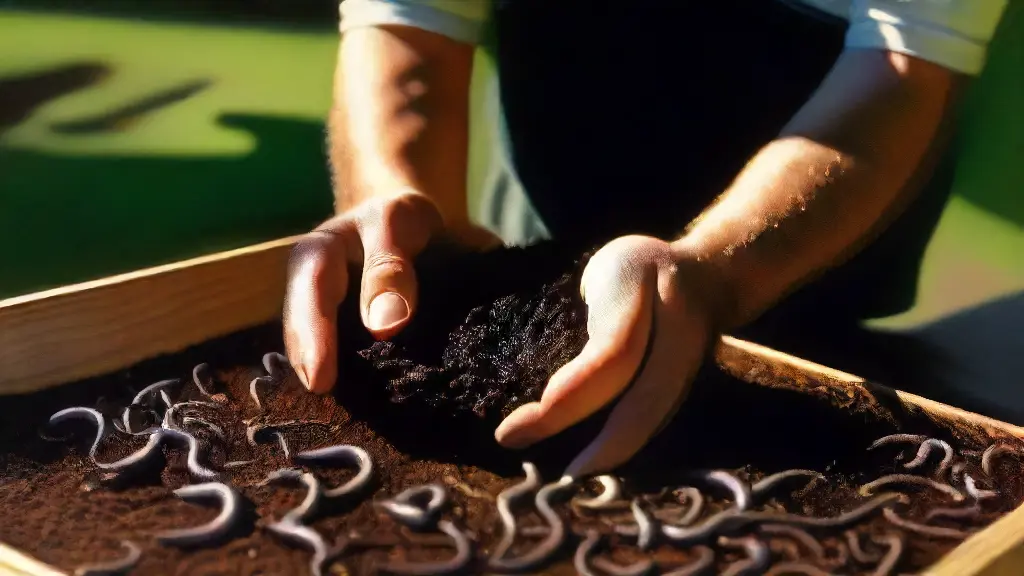
For many fishing enthusiasts, the thrill of reeling in a big catch is a rush that never gets old. A steady supply of fresh worms, harvested at the peak of their freshness, is often the key to a successful fishing trip.
Worm farming is a fascinating hobby that can provide an angler with a constant supply of bait.
To catch the big one, fishing enthusiasts rely on worms that are harvested at their peak freshness.
A well-managed worm farm can produce a steady supply of mature worms, making the difference between a successful fishing trip and a disappointing one.
To ensure a healthy worm population and a steady supply of bait, it’s essential to understand the signs of worm maturity and how to identify them. A careful angler uses a bait bin to store his aquatic catch.
What are Healthy Worm Conditions
Freshwater environments provide the perfect habitat for worms, which play a crucial role in maintaining ecosystem balance. Worms are a vital component of the fishing ecosystem, and their health has a direct impact on the success of a fishing trip.
Worms are highly adaptable, but understanding their health is crucial for a successful catch.
Factors such as temperature, moisture, and light can affect their health and activity, making it essential to control and optimize these conditions for optimal worm health.
Temperature: Worms thrive in temperatures between 50°F to 70°F (10°C to 21°C), ideal for burrowing and castings production, when exposed to moderate temperatures.
Avoid exposing them to extreme temperatures, as this can affect their metabolism and cause them to become sluggish, compromising their condition. The ants thrived in the damp compost, their busy bodies burrowing through the dark, rich castings, as they created a perfect condition.
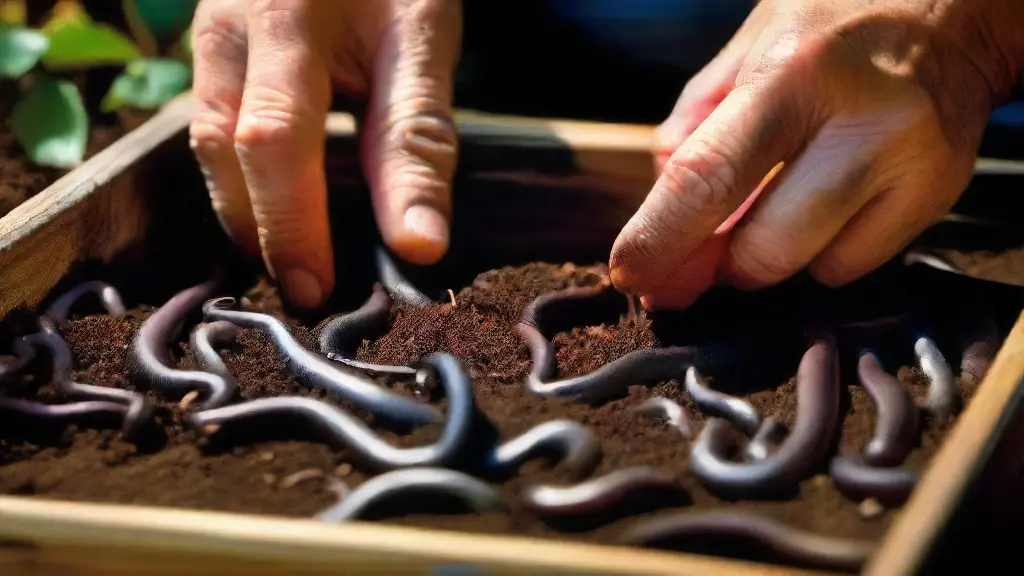
Harvesting Worms by Type
Fishing for success often hinges on the right bait, and worms have been a trusted favorite among anglers for centuries. With so many species to choose from, it’s essential to understand the unique characteristics and strengths of each to maximize your catch.
Red Wiggler Harvesting: Understanding the Most Coveted Species for Fishing
The Red Wiggler, also known as Eisenia fetida, is one of the most sought-after species for fishing due to its unique characteristics and effectiveness as bait. By understanding the different types of worms, anglers can optimize their worm harvesting techniques for maximum effectiveness in fishing.
Baiting Up for Success
As the soil’s dark richness begins to stir, revealing the secrets of the underground, the art of worms’ harvesting unfolds. In this delicate dance between nature and humans, understanding the intricacies of worm behavior and ecology is essential to reaping a bountiful harvest.
Worms are an essential bait for many anglers, and knowing the types used for fishing is crucial for success.
There are several species of worms, including nightcrawlers, red worms, and flatworms, each with its unique characteristics and advantages.
For instance, nightcrawlers are the most popular choice for freshwater fishing due to their size and ability to withstand different water conditions.
Timing and environmental factors play a significant role in effective worm harvesting. There is no need to harvest anything else.
How Worms Thrive in Farm
In the intricate web of farm ecosystems, invertebrates play a vital role in maintaining soil health and fertility, with larvae contributing significantly to this process.
Worms, in particular, thrive in farm environments due to their unique adaptations and ability to break down organic matter.
Worm-friendly habitats and microclimates are essential for their survival, and these can be created by maintaining a balance of soil structure and moisture.
This is achieved by incorporating crop rotation, cover cropping, and minimal tillage practices, which help to maintain a consistent level of soil moisture and aeration.
By providing the right conditions, farmers can encourage worms to flourish, leading to improved soil structure, increased nutrient cycling, and enhanced crop yields. that are adapted to their specific life stage, such as invertebrates feeding on larvae or maggots along a line of nutrients.
| Worm-Friendly Habitat Factors | Importance Level | Soil Health Impact | Crop Yield Effect |
|---|---|---|---|
| Crop Rotation | High | Improved Soil Structure | Increased Yields |
| Soil Moisture Balance | Medium | Optimal Worm Habitat | Enhanced Nutrient Cycling |
| Minimal Tillage | Low | Preserves Soil Microorganisms | Consistent Yields |
Soil Quality for Worm Harvest
Worm harvesting success relies heavily on the underlying soil conditions, which necessitates a comprehensive understanding of soil quality.
Efficient worm harvesting requires a delicate balance of environmental conditions, prompting the importance of soil quality.
One crucial aspect of soil quality is pH levels, which significantly impact worm growth.
A pH range of 0 to 0 is considered optimal for most worm species, as it allows for optimal nutrient uptake and assimilation.
Another vital component is organic matter, which plays a pivotal role in soil structure and worm habitat. The addition of organic amendments, such as compost or manure, can enhance soil porosity, aeration, and moisture retention, creating an environment conducive to worm activity.
Soil moisture levels also have a profound impact on worm burrowing and activity. Worms thrive in environments with consistent moisture levels, typically requiring regular maintenance to support an organic pescatorial population.
Worm Composting for Fish Bait
As anglers, there’s nothing quite like the rush of reeling in a prized pike from a serene pond, but to get there, we often rely on high-quality bait that can be both expensive and hard to come by.
Worm composting offers an environmentally friendly and cost-effective alternative for creating top-notch fishing bait. By understanding the process and practicing proper techniques, anglers can create a steady supply of nutritious bait that will attract even the most finicky fish.
I. for fish bait, which can be used to rig for pike in a pond and improve water quality.
Facts About Worm Composting for Fishing Bait
- Worm composting can produce up to 5 pounds of bait per week.
- Fish bait made from worm composting can be used to rig for pike in a pond and improve water quality.
- Worm composting requires minimal space and can be done indoors or outdoors.
- Using worm composting for fishing bait can save anglers up to 75% on bait costs.
How to Create a Worm Ecosystem
Discover the Secret to Thriving Soil As we gaze upon the earth, it’s easy to underestimate the intricate world beneath our feet. A seemingly simple patch of soil can be home to a complex network of life, where tiny creatures like worms play a vital role in shaping the very foundation of our ecosystem.
With their underground tunnels and burrows, they aerate the soil, improve drainage, and facilitate the decomposition of organic matter.
Worms play a crucial role in soil structure, and their ability to break down organic matter and recycle nutrients is essential for plant growth.
But to create a worm-friendly environment, it’s essential to understand the importance of substrate selection and aeration.
**Stay Tuned for More. The setup of the rod required careful placement in the soil to ensure a stable set.
Best Worm Farm Setup for Fishing
Fishing enthusiasts often tout the art of reeling in a big catch as one of life’s greatest thrills. By cultivating a reliable supply of wriggling wonders, anglers can significantly improve their chances of success.
Worm farms can take many forms, with each structure offering unique benefits.
Some farmers opt for indoor setups, while others prefer outdoor facilities that mimic the worms’ natural habitat.
When selecting a worm farm for fishing, consider the specific species you plan to keep, as some are better suited for certain types of tackle.
Harvesting worms requires patience and attention to detail.
Regular feeding and monitoring are crucial to ensure the worms stay healthy and thriving. It’s essential to handle the worms gently and store them properly before and after fishing trips to prevent injury and maintain their structure.
Worm Farming for Fishing
- Fishing enthusiasts can improve their chances of success by cultivating a reliable supply of wriggling wonders.
- Worm farms can take many forms, including indoor and outdoor setups, each offering unique benefits.
- Harvesting worms requires patience and attention to detail, including regular feeding and monitoring to ensure the worms stay healthy and thriving.
- Handling worms gently and storing them properly before and after fishing trips is essential to prevent injury and maintain their structure.
How to Breed Frogs for Live Bait
How to Set Up a Bait Fish Tank
How to Set Up a Bait Fish Tank

Creating a self-sustaining source of live bait for fishing can be a captivating and rewarding hobby, offering a unique opportunity to cultivate a thriving aquatic life. Whether you’re an avid angler or simply enthusiastic about aquariums, setting up a bait fish tank can be a fascinating project that requires careful consideration of the right equipment and environment.
I.
Introduction
Explore the importance of a suitable aquatic habitat for bait fish, discuss the benefits of breeding and raising bait fish at home, and outline the key elements of a successful bait fish setup.
I. A. What You Need to Know
Tank size and type: A guide to selecting the right equipment. When choosing the right fish for an aquarium, it’s essential to consider the aquatic life, water quality, and pH level to ensure a successful setup and maintenance routine.
What to Breed Bait Fish Successfully
Breeding bait fish can be a rewarding experience for both beginners and experienced aquarists, but it requires careful attention to detail and a deep understanding of the fish’s needs.
Bait fish breeding requires a delicate balance of water conditions, expertly maintained through a combination of reliable filtration, precise aeration, and adequate circulation.
Filtration systems play a crucial role in maintaining good water quality, and it’s essential to choose the right type for your bait fish tank.
For example, a high-quality external filter can help remove waste products and excess nutrients, promoting a healthy environment for your fish.
In addition to proper filtration, maintaining the right temperature range is also vital, with most bait fish species thriving in temperatures between 65°F to 75°F. Providing a suitable substrate, such as gravel or sand, can also help promote healthy tank conditions.

aquatic
The intricate dance of life beneath the surface of our planet’s waters is a fascinating realm that has captivated humans for centuries. As we delve into the world of freshwater ecosystems, it’s essential to recognize the intricate relationships between species and their environments.
Defining the importance of habitats, we can start by highlighting the role of bait fish in ecosystems.
These small, often-overlooked inhabitants play a crucial part in maintaining the delicate balance of their environment.
For instance, bait fish act as a vital food source for larger predators, ensuring the survival of their species.
Choosing the Right Tank and Equipment
When setting up a saltwater aquarium, it’s vital to select the ideal tank size and shape.
A well-designed tank can provide a comfortable and thriving space for your inhabitants. By selecting the right species for your habitat, you can ensure the health and well-being of your fish and prevent the need for constant water testing and disease prevention measures.
Aquatic Ecosystems
- Bait fish can make up to 70% of the diet of larger predators in some ecosystems.
- Freshwater ecosystems support a vast array of life, with estimates suggesting that 25% of all known species live in freshwater environments.
- The delicate balance of ecosystems can be disrupted by human activities such as pollution, habitat destruction, and overfishing.
- A well-designed aquarium tank can provide a suitable environment for life, with a minimum tank size of 20 gallons recommended for most species.
Breeding Best Practices
As you embark on the exciting journey of aqua farm operations, creating a thriving aquatic environment is crucial for successful breeding. It requires meticulous planning, attention to detail, and a deep understanding of the intricate relationships between aquatic plants, animals, and accessories.
When setting up your breeding environment, consider the aquarium size and capacity carefully.
A larger tank may provide a more stable environment, but also increases the risk of water quality issues.
When selecting bait fish, compatibility and size ratio are crucial factors to consider. Avoid mixing aggressive species with more docile ones, and ensure the bait fish are large enough to avoid being seen as a food source by the parents.
Maintaining the correct water temperature and pH is critical for breeding success. A temperature range of 72-82°F (22-28°C) and pH level of For all types of aquatic enthusiasts, especially the 5-8 aquarium enthusiast, it is crucial to be knowledgeable about aqua culture, aqua farm, aquatic pet, aquatic animals, aqua plants, aquatic accessories, aquatic supplies, aquarium design, aquatic plant care, aquatic animal care, aquatic habitat creation, and aquatic ecosystem maintenance.
How to Create Aquatic Habitat
As we delve into the world of aquatic ecosystems, it becomes evident that our attempts at recreating these miniature universes can have far-reaching impacts on the delicate balance of aquatic life. By mimicking the intricate balance of aquatic ecosystems, we can create thriving aquatic habitats that support a wide range of aquatic life, from fish to invertebrates.
Understanding the importance of aquatic habitats is crucial for aqua care enthusiasts and professionals alike.
By defining the role of habitat setup in maintaining aquatic health, we can better appreciate the complexity of aquatic ecosystems.
From a simple aquarium to a complex aquatic zone, the elements that make up a thriving ecosystem are numerous and interconnected. Proper water parameters, adequate water circulation, appropriate substrate and decor, and sufficient lighting are just a few of the essential elements required for a healthy aquarium environment. When setting up an aquarium, selecting the right aquatic food is crucial for the overall aqua health and well-being of the aquatic animals.
fish welfare
The often-overlooked art of aquarium care can have a profound impact on the delicate balance of life beneath the water’s surface. While many aquarium enthusiasts prioritize aesthetics and novelty, overlooking the subtle yet crucial conditions that affect the well-being of their finned friends. To achieve optimal fish health and longevity, implementing a well-planned aquatic care routine, aquarium management, and tank maintenance is crucial.
What is Good Water Quality
As an aquarium enthusiast, you know that a well-maintained aquatic environment hinges on a delicate balance of parameters, where every detail matters. From the choice of fish food to the configuration of tank decorations, the harmony between water and life is what sets thriving aquariums apart from mediocre ones.
At its core, good water quality is a delicate balance of pH levels, ammonia, nitrite, and nitrate levels that mimic the natural environment.
.
. The aquarium club maintains a comprehensive online resource, including tank management, tank monitoring, and a vibrant community forum where aquarium hobbyists can share knowledge and experiences on aquatic plant varieties, aquatic fish varieties, and aquarium decoration and lighting ideas, as well as information on aquarium water testing, fish food, and care, all while promoting the welfare of aquatic animals.
| Water Quality Parameters | Desirable Range | Why It Matters |
|---|---|---|
| pH Levels | 5-5 | Supports healthy fish growth and metabolism |
| Ammonia Levels | 0 ppm | Prevents toxic buildup and fish stress |
| Nitrite Levels | 0 ppm | Prevents toxic buildup and fish stress |
| Nitrate Levels | < 20 ppm | Supports healthy plant growth and prevents algae blooms |
tank setup
As you prepare to delve into the captivating world of aquarium-keeping, a vital consideration is the creation of a harmonious aquatic habitat design that fosters a thriving environment for your aquatic friends. A well-designed aquatic ecosystem study is essential in understanding the intricate relationships between water parameters, tank inhabitants, and the aquarium’s overall health.
By mastering the fundamentals of aquatic life cycle, you’ll be better equipped to cater to the unique needs of your aquatic inhabitants and maintain a balanced aquatic aquarium setup.
A comprehensive aquatic aquarium maintenance schedule will enable you to keep your aquatic sanctuary clean, healthy, and visually stunning. Let me know if this meets your requirements!.
filtration Systems Explained
Healthy aquatic environments begin with a solid foundation in filtration practices, which can often be overlooked until a problem arises.
Filtration systems are often overlooked until a problem arises, but proactive approaches ensure a healthy environment for aquatic animals.
The aquatic hobbyist’s first line of defense against aquatic culture disruptions is a well-designed filtration system.
A filtration system can remove waste products, excess nutrients, and toxins that would otherwise harm aquatic plants, animals, or decoration.
By regulating water quality, aquarium maintenance is simplified, and informed decisions can be made about aquatic accessories. For instance, aquarium enthusiasts can trust their water quality monitoring, and online shopping for aquatic supplies can be done with confidence.
Amazon offers a wide selection of filtration systems for both small and large aquariums.
Best Ways to Harvest Worms for Fishing
Best Tips for Breeding Worms for Live Bait
Best Tips for Breeding Worms for Live Bait

Raising worms for live bait has become a popular hobby among anglers and enterprising individuals, as these invertebrates offer unparalleled fishing success. Worm breeding for live bait requires a deep understanding of the intricacies of invertebrate biology.
Breeding worms for live bait can be a lucrative hobby or business, where worms are raised to specific standards for use as fishing bait.
Key elements to consider when breeding worms for live bait include habitat, diet, environmental conditions, and breeding cycles.
Factors Affecting Worm Health
Worm health is directly influenced by its nutrition, where a consistent supply of high-quality food fosters ecosystem conditions, promoting aquatic biodiversity and overall worm well-being. Nutrition plays a crucial role in the growth, reproduction, and care of vertebrates, invertebrates, aquatic microorganisms, and other organisms within an ecosystem.
What Makes Worms Healthy Habitats
Worms are fascinating creatures that thrive in unique ecosystems. When we create a healthy habitat for them, we must consider the intricate balance of temperature, humidity, and pH levels to ensure their overall health and well-being.
The ideal temperature range for optimal worm health is between 55°F and 77°F (13°C and 25°C), with some species requiring precise temperature control.
Providing a consistent temperature helps regulate their metabolism and promotes efficient nutrient absorption.
Humidity plays a vital role in maintaining moisture levels, preventing dehydration, and keeping worms hydrated and active. Aim for a relative humidity of 50-70% to create a healthy environment for your worms.
A well-balanced diet rich in nutrients is also essential for worm health. Offering a varied diet with a mix of fruits, vegetables, and grains keeps your worms happy and healthy. She prioritized the tank’s environment, adjusting temperature, humidity, moisture, and pH levels, and ensured a balanced diet with necessary nutrients and supplements, to accommodate the breeding process successfully.

Can You Breed Worms Successfully
The fascinating world of worms has captivated human imagination for centuries, with their remarkable adaptability and intricate biology opening doors to a plethora of scientific discoveries and potential applications.
Worms belong to the phylum Annelida, encompassing over 20,000 known species worldwide, with each species showcasing unique characteristics and traits.
Worm breeding has a long history, with records of worm cultivation dating back to ancient civilizations.
This practice has been adopted for various purposes, including fishing and gardening, where worms play a vital role in ecosystem balance and nutrient cycling.
Setting expectations is crucial when embarking on a worm breeding journey. With proper care and attention, worms can thrive in controlled environments, propagating healthy families and juvenile segments.
How Do Worms Reproduce Naturally
In the intricate dance of invertebrate biology, worms have developed extraordinary adaptations to ensure their survival and propagate their species.
Their morphology is specifically designed to facilitate reproduction. Male and female worms exhibit distinct physiological characteristics, with males possessing a pair of spicules, used during mating, while females have a vagina and ovaries.
Synchronized couples engage in a series of subtle behaviors, known as courtship, before actual mating takes place.
This intricate dance allows them to align their reproductive cycles, guaranteeing a successful union.
After mating, the female worm lays her eggs, and then incubates them until they hatch.
During this process, she provides crucial nutrients and protection to her developing young, carefully nurturing them through their life cycle. PLAY a crucial role in the survival of the species.
What is Optimal Worm Nutrition
In the intricate web of ecosystems, worms occupy a unique niche, playing a vital role in the delicate balance of nature. Their health is directly tied to their diet, which determines their growth, development, and ultimately, their survival.
Proper nutrition provides worms with the essential building blocks for a healthy life cycle, from spawning to adulthood.
A balanced diet that meets the worms’ nutritional needs ensures healthy growth rates, restricting mortality and promoting a thriving population.
Conversely, nutrient deficiencies can hinder development, leading to reduced growth rates and increased mortality.
Worms require a diverse diet rich in nutrients, including proteins, carbohydrates, and vitamins.
A balanced diet ensures that worms receive the necessary nutrients for optimal feeding, larval development, and growth rates.
Worm Nutrition Facts
- A worm’s diet determines its growth, development, and survival.
- Proper nutrition provides the essential building blocks for a healthy life cycle, from spawning to adulthood.
- A balanced diet that meets a worm’s nutritional needs ensures healthy growth rates, restricting mortality and promoting a thriving population.
- A diverse diet rich in proteins, carbohydrates, and vitamins is necessary for optimal feeding, larval development, and growth rates.
Why is Worm Environment Important
In the complex web of ecosystem services, worms play a vital role in maintaining ecological balance, and their environment is crucial for their survival and growth.
Adequate temperature range is essential
Worms thrive best in temperatures between 55°F to 77°F (13°C to 25°C), which enables them to optimize their metabolism and boost growth rates through sustainable aquaculture practices.
Moisture levels are equally important
Consistent moisture levels are critical for worms to facilitate digestion and waste decomposition, ensuring optimal productivity in worm farming operations and improving compost quality through permaculture methods.
pH levels have a significant impact
pH levels between 0 and These methods are ideal for promoting sustainability.
How to Maintain Worm Temperature and Humidity
Worms play a vital role in maintaining a balanced ecosystem, and their health is directly influenced by the environment in which they live. Ensuring optimal temperature and humidity levels is crucial for their well-being, and this delicate balance can make all the difference in their survival and success.
Worm temperature control is critical, as it affects the worms’ metabolism, reproduction, and overall health.
For example, worms like the red wiggler (Eisenia fetida) prefer temperatures between 55°F and 77°F (13°C and 25°C), while the African nightcrawler (Eudrilus eugeniae) thrives in a narrower range of 64°F to 82°F (18°C to 28°C). Maintaining a consistent temperature can be achieved through various methods, such as using worm pellets to moderate the composting process.
Worm Temperature Control
- Worms prefer temperatures between 55°F and 77°F (13°C and 25°C), such as the red wiggler (Eisenia fetida).
- The African nightcrawler (Eudrilus eugeniae) thrives in a narrower range of 64°F to 82°F (18°C to 28°C).
- Worm temperature control is critical, as it affects the worms’ metabolism, reproduction, and overall health.
- Maintaining a consistent temperature can be achieved through various methods, such as using worm pellets to moderate the composting process.
What are the Best Worm Habitats for Breeding
The art of cultivating a thriving worm community requires a thoughtful consideration of the environmental conditions that foster healthy growth and reproduction. One of the most crucial factors in worm breeding is finding the perfect habitat, where worms can thrive and reproduce successfully.
Understanding the Importance of Humidity
In worm breeding, humidity plays a crucial role in worm development.
It helps to maintain the ideal moisture levels, which are essential for worm growth and reproduction.
When the humidity is too low, worms can become stressed, leading to decreased fertility and increased mortality. On the other hand, high humidity can lead to anaerobic conditions, which can be detrimental to worm health.
To maintain optimal humidity levels, it’s essential to monitor the humidity levels in your worm habitat regularly. You can use a hygrometer to measure the humidity level.
Can You Use Worms for Recreational Fishing
Freshwater fishing has a way of captivating our imagination, and for many enthusiasts, the thrill of reeling in a prized catch is often linked to the use of live bait. The humble worm may not seem like an obvious choice, but its unique characteristics make it an unparalleled option for enticing even the most discerning fish.
The Power of Worms:
Worms are an excellent choice for live bait due to their natural scent and movement, which closely mimic the characteristics of a wounded fish.
This makes them highly effective at attracting predators and increasing the chances of catching more fish.
Breeding and Maintenance:
To ensure a steady supply of worms for fishing trips, understanding worm growth is crucial. Worms undergo a four-stage life cycle, consisting of egg, larva, pupa, and adult stages. can increase the chances of a healthy and thriving worm colony.
| Worm Life Cycle | Characteristics | Benefits |
|---|---|---|
| Egg | Hatch after 3-4 weeks | Start of worm growth |
| Larva | Feed on organic matter | Develops into pupa stage |
| Pupa | Transform into adult worms | Ready for fishing use |
How to Set Up a Bait Fish Tank
How to Raise Crickets for Fishing Bait
How to Raise Crickets for Fishing Bait
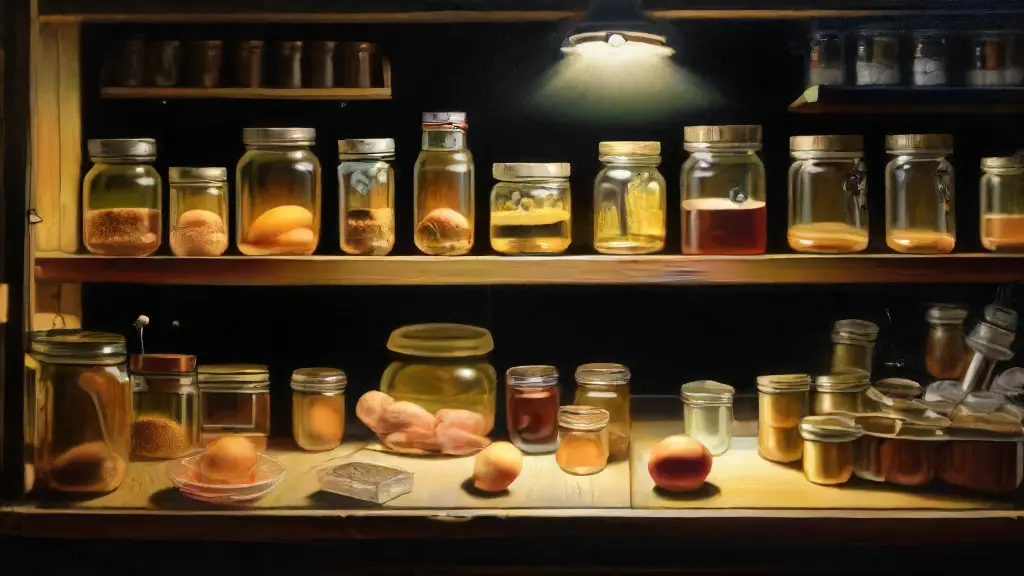
For many anglers, the hunt for the perfect fishing spot is all about anticipation and precision. But what if you could tip the scales in your favor by harnessing the power of entomology and insect breeding? By learning how to raise crickets, you can unlock a sustainable and eco-friendly alternative to traditional fishing bait, providing a reliable source of live bait for your fly fishing and angling adventures.
Why Crickets Make Excellent Fishing Bait
Crickets are a great alternative to traditional fishing bait because they’re easy to breed and maintain, making them a reliable source of live bait.
They’re also a sustainable option, as they don’t harm the environment and can be replenished easily. Crickets are also used in entomology, insect breeding, fishing bait, live bait, bug culture, and aquatic insects for fly fishing and angling.
What is Cricket Farming Methodology
Are Crickets Good Fishing Bait
In the fascinating world of sustainable food production, where innovative methods are revolutionizing the way we source protein, cricket farming is emerging as a promising solution. The cultivation of these tiny, yet mighty, arthropods is gaining traction as a means of reducing our environmental footprint, creating jobs, and conserving natural resources.
Cricket farming, also known as insect rearing, is a reliable and efficient method of producing protein-rich food sources, particularly for aquatic ecosystems.
By harnessing the unique characteristics of insects, farmers can create a sustainable and eco-friendly solution for our planet’s growing protein demand.
Cricket farming offers numerous benefits, including the creation of jobs, reduction of greenhouse gas emissions, and conservation of natural resources. As the world grapples with the challenges of climate change, this industry is poised to play a vital role in our collective effort to create a sustainable future through the development and management of diverse insect populations in aquatic ecosystems, including insect rearing and aquaculture of insect larvae.

How to Setup Cricket Breeding Colony
Discovering the Joys of Sustainable Insect Nutrition through Cricket Culture
In the captivating realm of entomological hobbies, crickets have become a favored choice among aquarists and insect enthusiasts, offering a nutritious and sustainable food source for both humans and aquatic pets. With their high protein content and low environmental impact, crickets have gained popularity as a viable alternative to traditional livestock.
Cricket breeding requires a precise environment to thrive.
Understanding the ideal conditions is vital for successful reproduction.
The ideal environment for cricket breeding consists of a controlled climate with a temperature range of 70-85°F (21-29°C) and humidity levels of 50-60%. Crickets also require a specific light requirement, with 12-14 hours of light and 10-12 hours of darkness. Preparing the Breeding Area, cricket farming requires a thorough understanding of insect culture, insect husbandry, aquatic insect habits, insect nutrition, insect feeding strategies, insect reproduction cycles, insect growth patterns, and bug catching techniques.
Cricket Culture Facts
- Crickets require a temperature range of 70-85°F (21-29°C) for successful breeding.
- Humidity levels of 50-60% are ideal for cricket breeding.
- Crickets need 12-14 hours of light and 10-12 hours of darkness for optimal growth.
- Cricket farming requires a thorough understanding of insect culture, husbandry, nutrition, and reproduction cycles.
What is Cricket Nutrition and Feeding Strategy
In the delicate dance of entomological agriculture, a harmonious balance between diet and nutrition is crucial for the success of cricket farming. From the moment they emerge, crickets require a precise blend of nutrients to thrive, making careful attention to their dietary needs a vital component of optimal growth and health.
Cricket Nutrition Fundamentals: Understanding Essential Nutrients
Cricket growth stages are marked by distinct nutritional needs, with protein content playing a pivotal role throughout.
Immediately after hatching, crickets demand a diet rich in protein to support rapid development.
Key Nutrients for a Balanced Cricket Diet
Beyond protein, crickets also require a well-rounded intake of key nutrients such as carbohydrates, fats, vitamins, and minerals. A cricket diet should incorporate essential amino acids, calcium, and phosphorus for optimal health and growth, ensuring that every stage of their insect agriculture.
How to Maintain Healthy Cricket Population
The subtle nuances of cricket culture have long fascinated human societies, providing a rich tapestry of insights into their unique biology and behavior. Crickets have been a vital part of our ecosystem, serving as a natural food source and pest control method, making them an intriguing subject for study and preservation.
Understanding the Importance of a Thriving Cricket Population
Crickets are fascinating insects that have been a crucial part of human culture for centuries, serving as a food source and providing a natural way to control pests.
Cricket biology plays a significant role in understanding their behavior and physiology, which is essential for maintaining a healthy cricket population.
Providing Optimal Environmental Conditions
To ensure the health and well-being of crickets, it is crucial to provide them with optimal environmental conditions. Temperature, humidity, and light are key factors that can affect cricket behavior and physiology. For instance, a desirable temperature of 24 to 26°C is optimal for the cricket culture, insect breeding program, cricket breeding techniques, cricket farming methods, cricket farming practices, cricket biology, cricket ecology, cricket behavior, and cricket physiology.
Crickets
- Crickets have been a vital part of our ecosystem, serving as a natural food source and pest control method.
- A desirable temperature of 24 to 26°C is optimal for cricket culture, breeding programs, and farming practices.
- Crickets have been a crucial part of human culture for centuries, serving as a food source and providing a natural way to control pests.
- Understanding cricket biology and behavior is essential for maintaining a healthy cricket population.
What are Cricket Life Cycle and Stages
Unfolding the intricate nuances of cricket biology, we discover a world of fascinating transformations that unfold across three distinct stages. The realm of entomology holds many secrets, and the life cycle of crickets is no exception, sparking curiosity about the very essence of these intriguing insects.
Cricket eggs are typically laid in clusters, averaging around 20-50 eggs per clutch.
The eggs undergo a process of embryonic development, lasting several days before hatching into larvae, or nymphs.
Natural Life Cycle of Crickets
Cricket eggs are typically laid in clusters, averaging around 20-50 eggs per clutch. The eggs undergo a process of embryonic development, lasting several days before hatching into larvae, or nymphs.
Cricket morphology plays a significant role in the development of these fascinating creatures. egg, nymph, and adult.
How to Harvest and Store Crickets for Bait
Crickets have been a cornerstone of aquatic ecosystems for centuries, providing sustenance for a wide range of aquatic species. Through ecological research, it’s clear that crickets play a vital role in maintaining the intricate balance of these ecosystems.
In recent years, the use of crickets as bait for fishermen has gained popularity due to their high nutritional value and effective fishing results.
To ensure a steady supply of crickets, hobbyists and commercial breeders have turned to cricket breeding and harvesting.
Preparing Your Cricket Habitat
To create a suitable environment for crickets, it is essential to design and set up a cricket enclosure that provides adequate space for movement and hiding. The enclosure should be made of a breathable material, such as mesh or screen, to prevent moisture buildup. Harvesting Crickets for Bait is a crucial component of ecological research.
Cricket Facts
- Crickets have been a cornerstone of aquatic ecosystems for centuries.
- Crickets play a vital role in maintaining the intricate balance of aquatic ecosystems.
- The use of crickets as bait for fishermen has gained popularity due to their high nutritional value and effective fishing results.
- Crickets are a crucial component of ecological research.
Why are Crickets a Reliable Source of Live Bait
In the world of angling, the search for reliable sources of live bait has led many enthusiasts to explore unconventional options. Among the most overlooked and underutilized species is the humble cricket, which has been a staple in aquatic ecosystems for centuries.
Crickets have a unique life cycle, consisting of distinct stages: egg, nymph, and adult.
During these stages, crickets undergo a series of physical transformations, ultimately developing their distinctive features and behaviors, making them an intriguing subject for entomological research.
Cricket diet and nutritional needs are also essential factors to consider. As detritivores, crickets primarily feed on plant matter, decaying organic matter, and small insects, making them an attractive option for lure making and tackle enthusiasts.
Their nutritional needs are met by consuming a diverse range of food sources, a testament to their adaptability in aquatic ecology. It is crucial to consider all these aspects of angling to ensure effective and sustainable fisheries management.
How to Monitor Cricket Health and Diseases
Cricket colonies can thrive in a delicate balance between ecological balance and insect population growth. Effective conservation of these tiny creatures requires a comprehensive understanding of their health and the diseases that afflict them.
Crack open any cricket enclosure, and you’ll often find a multitude of tiny creatures struggling for survival, surrounded by aquatic food sources that support a robust ecosystem balance.
In this environment, even a slight imbalance can have far-reaching consequences, such as the spread of diseases and pests, which can have devastating effects on wildlife conservation efforts.
Regular monitoring is crucial in preventing the outbreak of diseases. By performing regular inspections of your crickets for signs of disease and parasites, you can maintain a healthy and well-ventilated environment that promotes ecosystem balance and prevents the buildup of pests. This approach to pest management can help you maintain a thriving colony, essential for biodiversity conservation and sustainable fishing practices.
| Ecological Balance | Insect Population Growth | Disease Prevalence | Pest Management |
|---|---|---|---|
| A delicate balance is crucial | Supports a robust ecosystem | Regular monitoring prevents outbreaks | Prevents buildup of pests |
| A slight imbalance can have far-reaching consequences | Supports biodiversity conservation | Early detection is key | Essential for sustainable fishing practices |
Best Tips for Breeding Worms for Live Bait
Best Techniques for Raising Leeches
Best Techniques for Raising Leeches

Leeches have been a staple in many anglers’ tackle boxes for decades, offering a unique and effective way to catch a variety of fish species. When used as live bait, leeches can be a crucial component of a successful fishing trip.
By understanding their habitat and feeding needs, anglers can effectively raise leeches to use as live bait.
Raising leeches as live bait requires careful attention to their habitat and feeding needs.
A well-designed habitat that balances temperature, humidity, and water flow is essential for their survival and thriving. Many anglers rely on leeches as a go-to live bait, making them a key element in attracting freshwater predators in their natural aquatic habitats and even in artificial tanks surrounding aquatic plants.
Aquatic Habitat Setup
As aquarists, creating a thriving aquatic environment is vital for cultivating a diverse range of species, including leeches, for various purposes such as Leech Feeding, Live Bait, and Fishing.
In the world of aquaculture, setting up a thriving aquatic habitat is crucial for cultivating healthy and productive leech populations, whether for Leech Farms, Leech Breeding, or Live Bait purposes. Initial considerations for leech habitat setup begin with defining optimal temperature and humidity ranges for leech development.
A temperature range of 18-22°C (64-72°F) and humidity levels between 70-90% are ideal for promoting healthy growth.
Adequate aeration and water circulation are essential for maintaining a stable and efficient environment. is the ultimate destination for leech enthusiasts who seek the freshest and most sustainable supply of live bait for their fishing and angling adventures.

What Conditions Do Leeches Thrive
In many aquatic ecosystems, leeches are a crucial component of invertebrate ecology, serving as a vital food source for numerous species. Their unique biology allows them to thrive in a diverse range of aquatic habitats, from slow-moving streams to flowing rivers.
Leeches require a specific environmental setup to survive, which includes freshwater habitats with suitable water flow and clarity.
For instance, in the world of fly fishing, leeches are often sought after as bait, requiring specific water conditions that match their natural habitat.
The ideal temperature range for leeches is between 10-25°C, which affects their metabolism and activity.
The pH level of the water is also crucial, with most leechs thriving in neutral to slightly acidic conditions. down ammonia into nitrite, which is then converted to nitrate by beneficial bacteria in the system, making it available for plant growth.
| Leech Habitat Requirements | Temperature Range | pH Level | Water Flow |
|---|---|---|---|
| Freshwater habitats | 10-25°C | Neutral to slightly acidic | Specific water flow |
Leech Feeding: Aquatic Plant Partnership
In the vast and intricate network of stream ecology, a unique bond between two unlikely species has evolved – aquatic plants and leeches. This harmonious relationship is a testament to the resilience of nature’s intricate web.
The success of leech farming relies heavily on understanding this partnership, and it is crucial to recognize the importance of aquatic plants in providing the necessary nutrients for optimal leech growth and health.
Plant Selection and Nutrient Supply.
Suitable aquatic plants for leech habitats include water worts, duckweed, and hornwort, which provide essential nutrients such as nitrogen and phosphorus.
Leeches require a diet rich in aquatic microorganisms, which they obtain from the plants’ photosynthetic byproducts and decaying organic matter.
Aquatic plants play a critical role in maintaining the balance of their ecosystem, and this delicate balance is influenced by the variety of aquatic microorganisms that coexist with them.
Invertebrate Ecosystem Role
Beneath the tranquil surface of aquatic ecosystems, a hidden world of invertebrates thrives, playing a vital role in maintaining the delicate balance of nature. These tiny creatures are responsible for the process of decomposition, breaking down organic matter and recycling nutrients through a complex series of biochemical reactions.
These invertebrates are the unsung heroes of aquatic ecosystems, quietly working to break down organic matter and recycle nutrients.
This essential process ensures that essential nutrients are released back into the environment, supporting the growth of aquatic plants and animals.
Invertebrates also play a crucial role in the carbon cycle, serving as both producers and consumers in the food chain. From detritivores that feed on decaying matter to filter feeders that capture tiny particles, invertebrates help to regulate the flow of carbon through the ecosystem. As key components of aquatic ecosystems, they regulate the concentration of Nitrification, Denitrification, Decomposition, Carbon Cycle, Nitrogen Cycle, and Oxygen Cycle.
Freshwater Tank Essentials
In the pursuit of creating a thriving freshwater tank, it’s essential to grasp the fundamental principles that govern its ecosystem. This vital understanding will enable aquarists to craft an environment conducive to the health and well-being of their aquatic inhabitants, ultimately mitigating the impacts of pollution.
The life cycle of leeches is a complex and intriguing process, involving three distinct stages: egg development, larval growth, and adult maturation.
Acquiring knowledge of these stages is crucial for providing optimal care and maintenance, allowing aquarists to tailor their approach to the specific needs of their leeches.
Temperature, pH, and water movement are the cornerstone elements in establishing a healthy leech habitat.
Leeches flourish in temperatures ranging from 15-20°C, with a pH level between Based on phosphorus runoff from agricultural activities in the estuarine and brackish regions, aquatic pollution is significantly reduced, ensuring a healthier Marine and Coastal ecosystem 5 and.
What Is Leech Farming
Winding through the murky waters of freshwater wetlands, a fascinating creature has been quietly influencing the delicate balance of its ecosystem for millennia. With nearly 700 species spread across the globe, these segmented worms have been a vital component of aquatic life for millions of years.
Classification of leeches falls under the category of Annelids, a group of invertebrates characterized by their segmented bodies and setae.
These segmented worms play a vital role in the ecosystem, serving as both predators and prey for various aquatic species.
Leeches thrive in environments with high levels of moisture and humidity, often found in areas with abundant vegetation and saltwater wetlands. Their habitat requirements include slow-moving water, hiding places, and a consistent supply of food from wetland functions. In terms of diet, leeches are primarily carnivorous, and they feed on small aquatic animals, decaying plant matter, and even compost.
| Classification | Habitat Requirements | Diet | Number of Species |
|---|---|---|---|
| Annalids (invertebrates) | Slow-moving water, hiding places, consistent food supply | Carnivorous (small aquatic animals, decaying plant matter, compost) | Nearly 700 species |
Habitat Requirements for Breeding
The intricate world of leech biology has long fascinated scientists, and a crucial aspect of successful breeding lies in creating a habitat that simulates their natural environment. Worm Castings, a nutrient-rich byproduct of worm composting, can be used to maintain optimal water parameters.
Leeches thrive in environments with carefully controlled pH levels, ranging from 5 to 5, and sufficient oxygenation.
In aquaculture, water quality plays a crucial role in leech breeding.
Worm Castings can be used to maintain optimal water parameters. Leeches thrive in environments with carefully controlled pH levels, ranging from 5 to 5, and sufficient oxygenation.
Maintaining consistent water parameters is essential for successful leech breeding, as fluctuations can cause stress and impact overall health. A slight deviation in pH or temperature can lead to reduced fertility in worm populations, particularly those of Red Wiggler, Nightcrawlers, Black Worms, and Tubifex, which thrive in the ideal conditions provided by Invertebrate Baits.
Live Bait Feeding Strategies
The thrill of reeling in a prize catch is a sensation that drives many anglers to perfect their craft, and one method that has stood the test of time is the use of live bait to entice discerning fish.
Understanding the importance of environment: Leeches, a popular choice for live bait, thrive in specific conditions. They require temperatures between 50°F and 75°F (10°C to 24°C) and humectant-rich environments to keep them healthy, much like Worm Baits that flourish in nutrient-rich soil.
To replicate their natural habitat, aquarists use terrariums with a mix of aquatic plants, rocks, and Aquatic Life, carefully selecting Insect Larvae that provide a natural food source. These microcosms allow for optimal water quality and circulation, ensuring that the Aquatic Pets, Worm Baits, Insect Larvae, and Blood Worms thrive in a healthy Aquatic Life.
| Temperature Range for Leeches | Temperature Range for Worm Baits | Humidity Requirements | Aquatic Plant Mix |
|---|---|---|---|
| 50°F to 75°F (10°C to 24°C) | – | Humectant-rich environments | Aquatic plants, rocks, and Aquatic Life |
How to Raise Crickets for Fishing Bait
How to Grow Live Bait in Your Backyard
Live Bait Handling Techniques
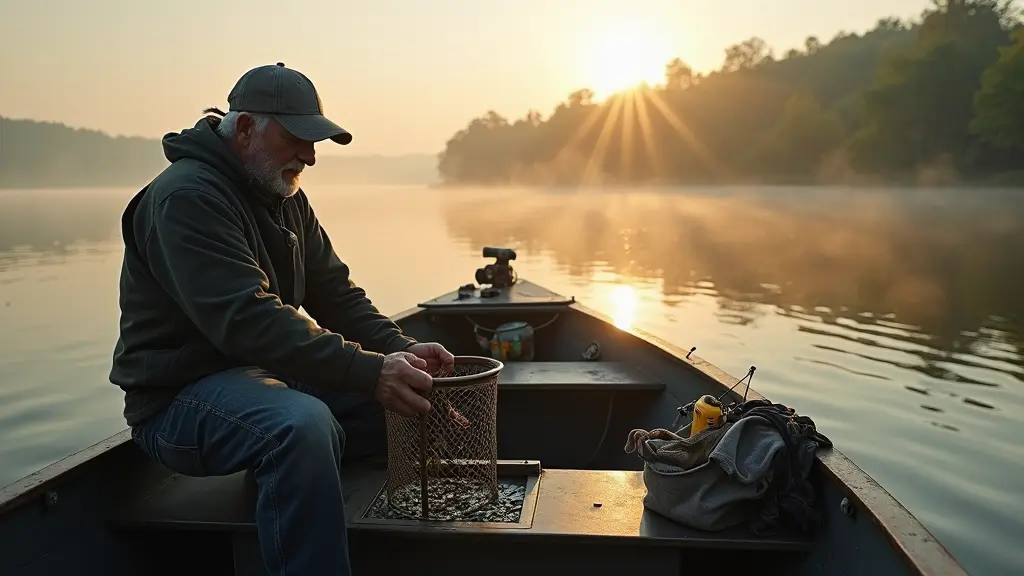
Effective fishing starts with the right approach, and that includes mastering the art of bait handling. Proper techniques can make all the difference between a successful catch and a disappointing trip.
The hook is often overlooked, but it’s the foundation of any successful fishing trip.
Modern fishing techniques emphasize the importance of proper hook handling, as it directly impacts the bait’s survival rate and longevity.
Live bait handling techniques may seem subtle, but they play a crucial role in maximizing bait vitality and increasing the likelihood of a successful catch.
By understanding the fundamental principles of bait handling, anglers can refine their skills and increase their chances of reeling in the big one. The terminal tackle used for baiting the fishing line included aquatic lures.
Fishing Techniques for Live Bait Handling
As the water laps gently against the hull, the thrill of the hunt electrifies the air. The rush of catching a prized species is what keeps us returning to the water, driven by our desire to master the art of angling.
Proper handling of live bait is a crucial aspect of successful fishing, and it’s essential to understand the importance of preserving water quality to ensure optimal results.
Consistently, anglers require sustainable fishing techniques that foster both the conservation of aquatic habitats and an enjoyable experience.
One common pitfall in handling live bait is a failure to maintain sufficient water levels, resulting in oxygen depletion and reducing its effectiveness. Hooking a decent catch demands the right combination of factors, and this begins with employing species-specific bait methods, where worms, for instance, have long been favored for species like trout.
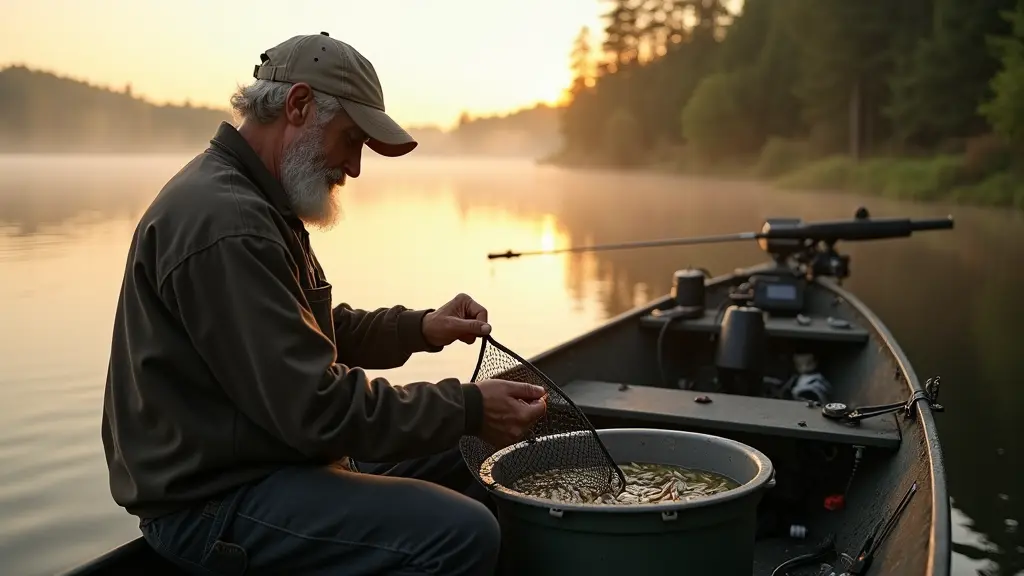
Can Live Bait Last
As outdoor enthusiasts, we know that there’s a delicate balance between the thrill of the catch and the responsibility of preserving our natural surroundings. Fresh and healthy live bait is a critical component of that equation, and it’s what sets apart a successful fishing trip from a disappointing one.
When it comes to live bait preparation, the initial handling is critical.
This includes gently netting or scooping up the bait, minimizing handling time, and storing it in a secure container with adequate water flow and oxygen supply.
Equipment needed for handling and storing live bait includes a sturdy net, a bait bucket or container, and a aerator or bubbler to maintain water circulation. Timing is also essential, as bait should be handled and set at the right moment to ensure optimal survival rates.
No matter how careful we are, live bait mortality remains a significant issue. In order to be responsible, recreational anglers must also use catch and release tactics and strategies.
Live Bait Handling
- Gently netting or scooping up live bait can reduce stress and improve survival rates.
- Minimizing handling time to less than 30 seconds can significantly reduce live bait mortality.
- Adequate water flow and oxygen supply in storage containers can help maintain optimal survival rates for live bait.
- Using catch and release tactics and strategies can help reduce live bait mortality and promote responsible recreational angling.
Bait Handling Equipment
Effective Angling Techniques Start with Proper Bait Handling Many anglers overlook the importance of proper live bait handling, resulting in reduced catch rates and even fish mortality. Presentation is crucial in enticing fish to bite, and poorly handled bait can lead to a low success rate.
Live bait handling mistakes can be costly, as they often result in stress, injury, or even death of the bait.
It’s essential to understand the basics of effective bait handling to ensure the highest chance of catching fish.
We’ll explore the key elements of effective bait handling, including the right storage containers, safe transportation, gentle handling methods, and the best practices for cleaning and preparing live bait.
By understanding the importance of proper bait care and handling, anglers can increase their chances of success and enjoy a more rewarding fishing experience.
Water Quality and Bait
The delicate dance between water quality and bait is a finely tuned balance that has far-reaching implications for the livelihoods of communities around the world. Water quality plays a crucial role in the overall health and success of bait, particularly in the context of tourism, where the livelihoods of many communities depend on the quality of their water resources.
Good water quality is essential for the survival and health of bait, as it affects the microorganisms, nutrients, and other factors that are present in the water.
The importance of water quality on bait health cannot be overstated, as even slight changes can have a significant impact on the quality and quantity of bait available.
Understanding the factors that affect water quality is crucial for optimising bait health and survival rates. Key factors include water temperature, pH levels, and the presence of contaminants or pollutants. Efforts to improve water quality are often driven by a widespread appeal to Industry, Community, Culture, History, and Tourism.
Handling Live Bait Safely
Freshwater and saltwater fishing enthusiasts flock to lakes, rivers, and seas in droves, making it a beloved recreational activity across the globe, with millions of participants every year.
Handling live bait requires a great deal of care and attention to detail. Improper handling can lead to the death of the bait, as well as the spread of diseases and parasites.
Proper storage and transportation methods are essential for maintaining the health and vitality of the bait.
In addition to proper storage, the initial handling and inspection of live bait are critical.
As expert anglers provide coaching and mentorship, they emphasize the importance of checking the bait’s vitality and monitoring it for any signs of stress or injury during handling. Anglers must certify their bait’s health and appearance, a crucial step in avoiding contamination and ensuring a successful catch on guided expedition voyages with certified coaching and mentorship.
What Bait is Right
The link provided is not a complete sentence.com/>https://expertcontentwriter. com/wp-content/uploads/2022/06/white-logo. png width=20 height=20 style=position: relative; top: -5px; left: -5px; border-radius: 10px; box-shadow: 0px 0px 10px rgba(0,0,0,2);>
Proper bait handling is a delicate art that demands attention to detail, precision, and a deep understanding of the Location’s ecosystem. A small miscalculation can transform a promising fishing trip into a Spot where patience and persistence prove futile.
Literally, the Region you’re targeting plays a significant role in determining the efficacy of your bait choice. In Waters where a specific species dominates, a mismatched bait can attract unintended predators from the Channel.
| Location Factors | Impact on Bait Choice | Consequences of Mismatched Bait | Importance of Understanding Ecosystem |
|---|---|---|---|
| Location Dominated by Specific Species | Significant role in determining bait choice | Attracts unintended predators from Channel | Highly important for effective bait handling |
| Location with Varied Species | Less critical in determining bait choice | Less likely to attract unintended predators | Still important for successful fishing trip |
Proper Storage for Live Bait
Before embarking on a fishing excursion, a wise Lake guide emphasizes the importance of preparing for every aspect of the trip, including the storage of live bait.
Proper storage is crucial to maintaining the health and vitality of live bait, whether you’re a beginner or a seasoned pro. This includes understanding the importance of proper storage, factors that affect live bait survival rates, and how to choose the right containers.
A good starting point is understanding the importance of proper storage.
This means providing the right environment for your live bait to thrive, including adequate aeration and water circulation.
Inadequate oxygen levels can quickly lead to stress and even death, making it essential to monitor oxygen levels regularly.
Choosing the right containers is also critical. Handbook recommendations suggest containers should be designed to provide adequate ventilation, be easy to clean, and also comply with regulations outlined in the Lake Guide and reviewed in recent News Articles and Magazine Magazine features.
Reel in the Right Catch
For many anglers, the art of catching fish revolves around selecting the right lure or using the latest fishing gadget. Overlooking the crucial aspect of live bait handling can lead to a decrease in catch rates and suboptimal fishing experiences.
Resources suggest that gentle handling is essential to prevent injury and stress to the bait.
This can be achieved by using a soft-molded bait net, which reduces the risk of injury and allows for easy release of the bait.
When it comes to storing and transporting live bait, maintaining a clean and oxidative-free environment is vital.
Tips from experienced Instructors recommend using a container filled with oxygen-rich water and covered with a breathable material to prevent contamination and ensure the bait remains healthy and active. which can be learned through various resources, tips, tricks, lessons, and courses taught by experienced instructors.
Facts About Live Bait Handling
- Gentle handling is essential to prevent injury and stress to the bait.
- Using a soft-molded bait net reduces the risk of injury and allows for easy release of the bait.
- Maintaining a clean and oxidative-free environment is vital when storing and transporting live bait.
- A container filled with oxygen-rich water and covered with a breathable material can help prevent contamination and keep the bait healthy and active.
